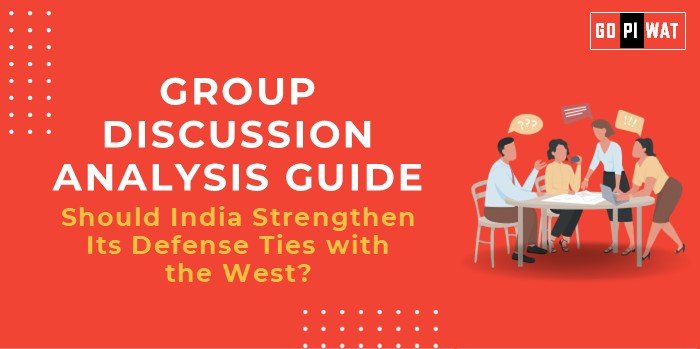📋 Group Discussion (GD) Analysis Guide
🌟 Should India Strengthen Its Defense Ties with the West?
🌐 Introduction to the Topic
Context Setting: In the evolving global order, nations like India face increasing pressures to align with strategic alliances for security and geopolitical stability. Strengthening defense ties with Western nations such as the U.S., U.K., and European allies poses significant implications for India’s strategic autonomy, regional influence, and security preparedness.
Background: India’s current defense partnerships with the West include agreements like the Basic Exchange and Cooperation Agreement (BECA) with the U.S. and ongoing technology collaborations with countries like France and the U.K. Balancing these ties while maintaining a multipolar diplomatic approach is vital as India navigates its role as a regional power in Asia.
📊 Quick Facts and Key Statistics
- 💰 Defense Budget 2024: $72.6 billion – Third highest globally, underscoring India’s security priorities.
- 🤝 U.S.-India Defense Trade: $21 billion (2024) – Highlighting growing bilateral defense relations.
- 📈 Arms Imports: 11% of global imports (SIPRI, 2023) – Reflecting India’s dependency on external suppliers.
- 🌍 Quad Alliance: Defense collaboration with the U.S., Japan, and Australia signals India’s strategic Westward tilt.
👥 Stakeholders and Their Roles
- 🇮🇳 Indian Government: Strategic decision-making and fostering indigenous defense industries.
- 🌐 Western Nations: Offering advanced technologies and joint development opportunities.
- 🏭 Domestic Defense Sector: Collaborating on projects like the Tejas fighter jets and missile systems.
- 🌏 Regional Powers: China and Pakistan view stronger India-West ties as potential threats to their influence.
🏆 Achievements and Challenges
- 🎯 Achievements:
- Advanced Technology Access: Collaborations with Western nations have enhanced India’s missile systems, avionics, and surveillance technologies.
- Enhanced Maritime Security: Joint naval exercises in the Indo-Pacific reinforce regional stability.
- Global Positioning: Closer ties with Western nations strengthen India’s role in global strategic platforms like QUAD and G20.
- ⚠️ Challenges:
- Strategic Autonomy: Critics argue deeper alignment with the West might compromise India’s independent foreign policy.
- Dependency on Imports: Over-reliance on Western technology could undermine self-reliance goals.
- Geopolitical Tensions: Risk of alienating non-aligned partners like Russia and China.
🌍 Global Comparisons
- 🇦🇺 Australia: Successfully balanced U.S. ties while maintaining regional diplomacy.
- 🇹🇷 Turkey: Struggled with NATO alignment due to conflicting regional strategies.
Case Studies:
- 📜 India-U.S. COMCASA Agreement: Facilitated secure communications and interoperability but raised concerns over data security.
📋 Structured Arguments for Discussion
- ✔️ Supporting Stance: “Stronger defense ties with the West provide India access to cutting-edge technologies and strengthen its deterrence against regional threats.”
- ❌ Opposing Stance: “Relying too heavily on Western defense systems undermines India’s strategic autonomy and risks entanglement in their geopolitical conflicts.”
- ⚖️ Balanced Perspective: “While partnerships with the West are crucial for advanced technologies, India must complement these with self-reliance initiatives like ‘Make in India’.”
🛠️ Effective Discussion Approaches
- 🔍 Opening Approaches:
- Statistical Highlight: “India’s defense budget is the world’s third-largest, yet over 50% of its weaponry is imported, showcasing the need for balanced partnerships.”
- Case Study Introduction: “The India-U.S. COMCASA agreement is a milestone but raises questions about data security and dependency.”
- 💬 Counter-Argument Handling:
- Example: “While dependency is a concern, joint ventures like Rafale production highlight efforts to localize technology transfer.”
📈 Strategic Analysis of Strengths and Weaknesses
- 🟢 Strengths: Access to cutting-edge technologies, enhanced maritime security, strategic positioning in global alliances.
- 🟡 Weaknesses: Dependency on imports, risk of geopolitical entanglements.
- 🔵 Opportunities: Joint ventures, indigenous production, diversification of suppliers.
- 🔴 Threats: Alienation of non-aligned allies, potential escalation with regional adversaries.
📚 Connecting with B-School Applications
- 🌏 Real-World Applications: Explore frameworks for public-private partnerships in defense or strategies to balance global trade and security policies.
- 🤔 Sample Interview Questions:
- “How can India leverage defense ties with the West to boost indigenous production?”
- “What are the risks of aligning closely with Western nations?”
- 💡 Insights for B-School Students:
- Understanding global supply chain dependencies in defense.
- Evaluating strategic decision-making in volatile geopolitical environments.


